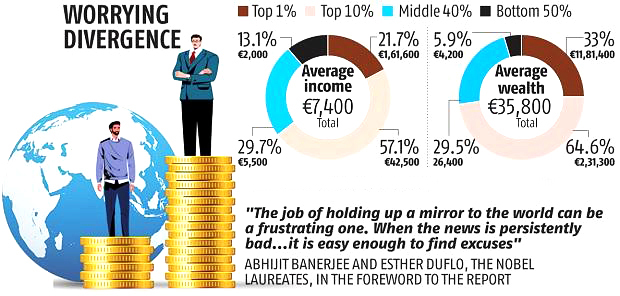World Inequality Report 2022 | 08 Dec 2021
Why in News
According to the recently released World Inequality Report 2022, India is now among the most unequal countries in the world.
- The report was released by the World Inequality Lab, which aims to promote research on global inequality dynamics.
- This report presents the most up-to-date synthesis of international research efforts to track global inequalities.
Key Points
- Findings about the World:
- Distribution of Wealth:
- The poorest half of the global population “barely owns any wealth” possessing just 2% of the total, whereas the richest 10% of the global population own 76% of all wealth.
- The Middle East and North Africa (MENA) are the most unequal regions in the world, whereas Europe has the lowest inequality levels.
- The poorest half of the global population “barely owns any wealth” possessing just 2% of the total, whereas the richest 10% of the global population own 76% of all wealth.
- Gender Inequalities:
- Women’s share of total incomes from work (labour income) was about 30% in 1990 and is less than 35% now.
- Inequalities within countries are now greater than those observed between countries.
- At the same time, the gap between the average incomes of the top 10% and the bottom 50% of individuals within countries has almost doubled.
- Rich Countries Poor Governments:
- Over the past 40 years, countries have become significantly richer, but their governments have become significantly poorer.
- The currently low wealth of governments has important implications for state capacities to tackle inequality in the future, as well as the key challenges of the 21st century such as climate change.
- Impact of Covid Crisis on Inequality:
- The Covid-19 pandemic and the economic crisis that followed hit all world regions, but it hit them with varying intensity.
- Europe, Latin America, and South and Southeast Asia recorded the largest drops in national income in 2020 (between -6% and -7.6%) while East Asia (where the pandemic began) succeeded in stabilizing its 2020 income at the level of 2019.
- Distribution of Wealth:
- India Specific Findings:
- Distribution of Wealth:
- India stands out as a poor and very unequal country.
- The top 1% of the population hold more than one-fifth of the total national income in 2021 and the bottom half just 13%.
- The economic reforms and liberalization adopted by India have mostly benefited the top 1%.
- India stands out as a poor and very unequal country.
- Average Household Wealth:
- It stands at Rs. 983,010. It has been observed that the deregulation and liberalisation policies implemented since the mid-1980s have led to “one of the most extreme increases in income and wealth inequality observed in the world”.
- Gender Inequalities:
- The female labour income share is equal to 18% which is significantly lower than the average in Asia [21%, excluding China] and this value is one of the lowest in the world.
- Carbon inequality
- India is a low carbon emitter. The average per capita consumption of greenhouse gas is equal to just over 2 CO2e.
- Carbon dioxide equivalent or CO2e is a term for describing different greenhouse gases in a common unit.
- These levels are typically comparable with carbon footprints in sub-Saharan African countries.
- The bottom 50% consume one, the middle 40% 2 and the top10%, 9 CO2e/capita.
- A person in the bottom 50% of the population in India is responsible for, on average, five times fewer emissions than the average person in the bottom 50% in the European Union and 10 times fewer than the average person in the bottom 50% in the US.
- India is a low carbon emitter. The average per capita consumption of greenhouse gas is equal to just over 2 CO2e.
- Rise of Private Wealth:
- There has been a rise of private wealth in emerging countries such as China and India.
- China has had the largest increase in private wealth in recent decades. The private wealth increase seen in India over this time is also remarkable (up from 290% in 1980 to 560% in 2020).
- Distribution of Wealth:
- Suggestions:
- The report suggested levying a modest progressive wealth tax on multimillionaires.
- Given the large volume of wealth concentration, modest progressive taxes can generate significant revenues for governments.
- Related Reports:
- India Inequality Report 2021:
- The World Inequality Lab “India Inequality Report 2021: India’s Unequal Healthcare Story” released earlier this year shows that the socio-economic inequalities seep into the health sector and disproportionately affect health outcomes of marginalised communities due to the absence of Universal Health Coverage (UHC).
- Multidimensional Poverty Index (MPI):
- According to the recently released, Multi-dimensional Poverty Index (MPI) prepared by Niti Aayog, one in every four people in India was multidimensionally poor.
- India Inequality Report 2021:
World Inequality Lab
- About:
- It is a research laboratory focusing on the study of inequality worldwide. The WIL hosts the World Inequality Database, the most extensive public database on global inequality dynamics.
- It gathers social scientists committed to helping everyone understand the drivers of inequality worldwide through evidence-based research.
- Missions:
- The extension of the World Inequality Database
- The publication of working papers, reports and methodological handbooks
- The dissemination in academic circles and public debates

